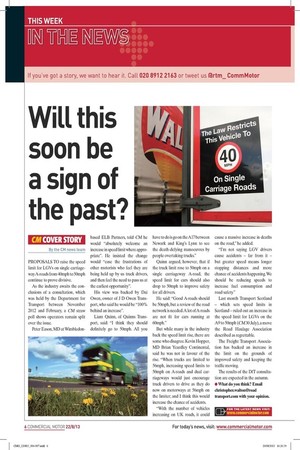Will this
Page 4

If you've noticed an error in this article please click here to report it so we can fix it.
soon be
a sign of
the past?
PROPOSALS TO raise the speed limit for LGVs on single carriageway A-roads from 40mph to 50mph continue to prove divisive.
As the industry awaits the conclusions of a consultation, which was held by the Department for Transport between November 2012 and February, a CM straw poll shows operators remain split over the issue. Peter Eason, MD at Wimbledon
based ELB Partners, told CM he would "absolutely welcome an increase in speed limit where appropriate". He insisted the change would "ease the frustrations of other motorists who feel they are being held up by us truck drivers, and then feel the need to pass us at the earliest opportunity".
His view was backed by Dai Owen, owner of J D Owen Transport, who said he would be "100% behind an increase". Liam Quinn, of Quinns Transport, said: "I think they should definitely go to 50mph. All you
have to do is go on the A17 between Newark and King's Lynn to see the death-defying manoeuvres by people overtaking trucks."
Quinn argued, however, that if the truck limit rose to 50mph on a single carriageway A-road, the speed limit for cars should also drop to 50mph to improve safety for all drivers.
He said: "Good A-roads should be 50mph, but a review of the road network is needed.A lot of A-roads are not fit for cars running at 60mph."
But while many in the industry back the speed limit rise, there are some who disagree. Kevin Hopper, MD Brian Yeardley Continental, said he was not in favour of the rise. "When trucks are limited to 56mph, increasing speed limits to 50mph on A-roads and dual carriageways would just encourage truck drivers to drive as they do now on motorways at 56mph on the limiter; and I think this would increase the chance of accidents. "With the number of vehicles increasing on UK roads, it could
cause a massive increase in deaths on the road," he added.
"I'm not saying LGV drivers cause accidents — far from it — but greater speed means longer stopping distances and more chance of accidents happening. We should be reducing speeds to increase fuel consumption and road safety."
Last month Transport Scotland — which sets speed limits in Scotland — ruled out an increase in the speed limit for LGVs on the A9 to 50mph (CM30 July), a move the Road Haulage Association described as regrettable.
The Freight Transport Association has backed an increase in the limit on the grounds of improved safety and keeping the traffic moving.
The results of the DfT consultation are expected in the autumn.
• What do you think? Email christopher.walton@road transport.com with your opinion.









































